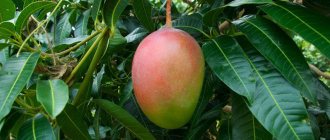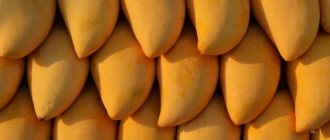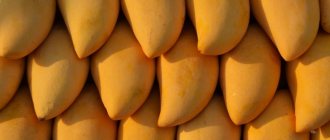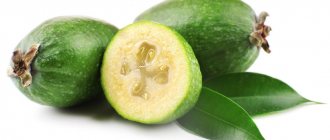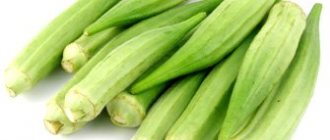- March 29, 2019
- Tips for tourists
- Natalia Bardo
Mango is a unique exotic fruit that is loved by many Russians. As practice shows, when choosing this fruit in a store, not every person can determine its ripeness, which is why disappointments often occur. Let us next consider the main features of choosing a mango, as well as the main signs by which the sufficient ripeness of the fruit can be determined.
What is mango?
Mango is a round or oval-shaped tropical stone fruit, approximately the size of a grapefruit. The color of the skin varies from yellow to green or red-orange, depending on the variety, and the inside contains soft yellow flesh and a hard, large seed.
Mangoes grow only in warm climates. They are native to South Asia but are now grown in other countries, including the United States, Mexico and the Caribbean.
The popularity of mango is great and it is one of the most widely consumed fruits in the world. It is often called the "king of fruits."
India accounts for almost half of the world's sales of this fruit, while China is the second largest producer of mangoes.
What does a mango look like - photo
general description
Mango is one of the most delicious seasonal fruits grown in the tropics. The tree is believed to be native to India. Botanically, it belongs to the Anacardiaceae family, which also includes numerous species of tropical fruiting trees, such as cashew, pistachio.
Scientific name of mango: Mangifera Indica.
Mangoes come in different shapes and sizes depending on the variety. Typically the fruit is 5 to 15 cm long and 4 to 10 cm wide, with the typical shape being oval or round. Weight ranges from 150 g to 750 g.
The rind is smooth and green in unripe mangoes, but turns golden yellow, crimson red, yellow or orange-red when ripe, depending on the variety.
There are also green varieties of mangoes, they are popular in Thailand, India and Malaysia.
Inside, the pulp is juicy, oily, orange-yellow in color with numerous soft fibers emanating from a flattened oval bone located in the center.
Do I need to peel it?
Mango is a great dessert. It can be eaten raw by cutting off the crust, or it can be used as an ingredient in dishes. Salads, appetizers, main courses with meat and fish are prepared with it, subjecting the fruits to heat treatment. Juice from the fruit is good. Culinary masterpieces with mangoes also have their fans.
Before cooking, wash the fruit and remove the crust. The pulp is chopped. If the fruit is hard, you can cut it into pieces. If it is soft, then in order to remove the pulp, you can take an ordinary spoon and scrape the pulp from the walls of the peel.
Why are mangoes eaten without the peel? It's all about its hardness and toxic composition. The peel protects the pulp from external factors, and this is its main purpose. But the peel should not be eaten. It contains the toxic resin urushiol, which is hazardous to health. Even a small amount of peel eaten can cause stomach and intestinal disorders.
Urushiol may also cause an allergic reaction. Some people, especially those prone to allergies, will easily get sick even if they touch mango peel. Redness and blisters appear on the skin, like a nettle burn. Such people need to be extremely careful when feasting on exotic fruit.
How and where it grows
Mango trees grow quite large and can reach 30 meters in height or more. Some of them have been growing for more than 300 years and still continue to bear fruit.
The leaves of the mango tree are large, leathery, 12 to 40 cm long and remain on the tree throughout the year. Young foliage is orange-pink but fades to a deep glossy red and becomes dark green as it matures.
Flowers develop in panicles or clusters 10-40 cm long. Each flower is small, with white petals and a mild, sweet scent. They are pollinated by insects, of which less than 1% produce fruit.
A mango tree in bloom is a beautiful sight.
Some of the fruits on the tree receive more sunlight than others, which always remain in the shade of the leaves. Mangoes that ripen under the sun's rays develop a red blush on their skin. However, it is not an indicator of maturity, quality or sweetness.
It will take about four months before the mango is ready for harvest.
Fruits for sale are usually picked while they are green; they ripen well at home. Overripe fruits fall to the ground and may spoil.
The fresh mango season lasts from April to August.
Plant care
Further cultivation of the seedling is not particularly difficult. The main thing is to ensure:
- sunny location - south window sill;
- regular watering - 1-2 times a week with settled water at room temperature;
- daily foliar spraying.
This type of care is recommended for all non-hairy indoor plants that come from the tropics.
Mango loves irrigation with water from a spray bottle and shower head, wiping the leaves with a damp cloth, and open air in the summer on a balcony or terrace.
Feed the tree with universal complex fertilizer for indoor plants during watering.
A period of rest in winter is not required, but additional lighting with a phytolamp is welcome.
To form a crown at the 8-leaf stage, it is necessary to pinch the tip of the shoot.
Annual spring pruning is carried out when the plant reaches one and a half meters in height.
For the first three years, the tree is replanted once a season, selecting a pot or tub of the required (larger) size; subsequently, it is replanted once every three years.
Where to buy and how to choose
In stores, mangoes are sold in canned, fresh and dried forms. When purchasing fresh fruit, choose fruits that are heavy for their size. Smell them; they should be fragrant. Immature ones have no smell.
If you are going to eat mangoes right away, look for soft fruits. A mango is ripe if it can be pressed lightly with your thumb. Avoid overripe fruits with brown marks - they have already lost their flavor and will spoil very quickly.
The color of the peel is not the best indicator of ripeness; it is best to touch the fruit. Press it lightly, the ripe mango will be soft to the touch.
Aroma
How to identify a ripe mango? Fans of this fruit note that this can be done by its aroma: the more intense and sweeter the smell, the riper the fruit.
In order to determine the ripeness of a fruit, you need to smell it in the area of the stalk - there the aromatic properties are most intense. As for the distinctive features of the aroma, it resembles the taste of mango. This is due to the fact that the perception of taste and aroma are closely interrelated.
If the mango stalk emits a sour or, worse, alcoholic smell, then you should refuse to purchase the product - this smell is a sign that the fruit has begun to rot, which is why its taste will be simply disgusting. This feature of the fruit is associated, first of all, with the increased sugar content in the fruit, which, when overripe, causes the process of active fermentation. This is what causes the presence of an unpleasant alcoholic odor.
How to properly cut and eat a mango
Mango fruits are eaten raw without any seasonings/additives to experience their rich taste.
Before cutting and eating mangoes, wash the fruit in cold running water to remove dust/dirt and any chemical residue from the surface. Wipe the peel with a soft towel.
Although the peel is not poisonous, mangoes are usually eaten without it. It can taste bitter and tough. Often an allergy develops to it, which manifests itself in irritation around the mouth.
Cubes
Cut the mango into three parts so that the middle part consists of a seed. Then cut the peel into 2-3 cm strips to separate it from the pulp. Cut the flesh crosswise to make square pieces.
Step-by-step instruction:
- Using a sharp knife, cut through the mango on either side of the center seed. This way you will get two large halves of the fruit and a central part with a stone.
- Then take one half and cut the flesh horizontally and vertically, being careful not to cut deep into the skin.
- Turn half the fruit inside out to push out the cubes as shown in the photo.
Slices
Another way to quickly peel and eat mangoes:
- Cut the mango on both sides, passing the pit.
- Chop the pulp without damaging the skin.
- Separate the slices with a tablespoon and enjoy!
Separator
To clean mangoes, you can purchase a special device - a separator. It can be bought in stores specializing in kitchen utensils, or ordered from online stores.
- Place the fruit on a cutting board and hold it with your hand. Place a mango divider on top so that the opening is level with the widest part of the fruit.
- Press down on the tool to release the mango pulp from the seed.
- Use any of the methods mentioned above on rblogs.ru to separate the pulp from the peel into cubes or slices.
You can also peel the mango with a vegetable peeler and place it on a cutting board.
Top dressing
To form a beautiful crown of a tree, we need to fertilize it in early spring - this is a time of rapid growth. Organic fertilizers should be added to the soil once every 2 weeks: in spring and summer. Additionally, 3 times a year you can feed with microfertilizers.
Mangoes should not be fertilized in autumn. For the proper development of the tree, it is better to choose the right balanced fertilizer, then the plant will delight its owners with delicious fruits.
Use in cooking and recipes
Mango pairs well with other tropical fruits such as bananas and pineapples. It can be mixed with plain low-fat yogurt.
Here are some useful tips on what to eat mango with:
- In Asian countries it is used to make chutney sauce.
- Fresh cubes of mango pulp are a great addition to fruit salads.
- Used for making jam, preserves, jelly, ice cream.
- Mango juice with ice cubes is a popular, delicious drink.
How to make mango ice cream - a simple recipe
This mango ice cream recipe is common in India. The cooking method is very simple.
Ingredients:
- 2 ripe sweet mangoes (you can take 3 mangoes if they are not very large);
- 1 can of condensed milk;
- 200-250 ml heavy cream (33%).
How to cook:
- Carefully remove the mango pulp as per the instructions above.
- Place the ingredients in a blender and blend until completely smooth.
- Pour the mixture into molds or one large bowl and place in the freezer until almost set.
- Remove from freezer and whisk thoroughly until all lumps are gone. This will prevent ice crystals from forming and give a smooth texture.
- Place the ice cream back into the freezer and leave until it is completely done.
Methods for ripening the fetus at home
If you accidentally bought an unripe hard fruit, do not be upset. It can be matured at home. Ripening under normal conditions can take up to a week, but this process can be significantly accelerated.
In paper
If you wrap a mango in newspaper, parchment or a paper bag and leave it at room temperature overnight, there is a chance that the fruit will ripen by morning. This happens due to the fact that under such conditions the release of ethylene is accelerated, which affects the ripening process.
You don't need to wrap the mango too tightly. Air must penetrate under the layer of paper. Otherwise, a fungus may develop, triggering the rotting process.
Ripening in a paper bag.
In rice
This method is rooted in the centuries-old history of India. If you place unripe fruit in rice, ripening will occur much faster. This also happens due to the release of ethylene. It is important to ensure that the rice is fresh and dry. The ingress of moisture, even in small quantities, can lead to product spoilage.
Do not forget to check the condition of the mango every 6 hours, because... under these conditions, there is a risk of rapid overripening of the fetus.
Ripening in rice.
In a dark place
If you put the mango in a dark place, the ripening process will take place in a shorter time than in the light. A closet or drawer that is rarely used during the day is suitable for this purpose. It is important that there are no products or other substances with a strong odor inside, because the mango can absorb it.
Chemical composition and calorie content
Nutritional value per 100 g of mango pulp (Mangifera indica):
- Calories: 70 cal.
- Carbohydrates: 17 g
- Dietary fiber: 1.8 g
- Fat: 0.27 g
- Protein: 0.5 g
| Vitamins and minerals | Quantity | % of daily value |
| Folates | 14 mcg | 3,5 |
| Niacin | 0.584 mg | 3,5 |
| Pantothenic acid | 0.160 mg | 1 |
| Pyridoxine | 0.134 mg | 10 |
| Riboflavin | 0.057 mg | 4 |
| Thiamine | 0.058 mg | 5 |
| Vitamin A | 765 ME | 25,5 |
| Vitamin C | 27.7 mg | 46 |
| Vitamin E | 1.12 mg | 7,5 |
| Vitamin K | 4.2 mcg | 3,5 |
| Potassium | 156 mg | 3 |
| Calcium | 10 mg | 1 |
| Copper | 0.110 mg | 12 |
| Iron | 0.13 mg | 1,5 |
| Magnesium | 9 mg | 2 |
| Manganese | 0.027 mg | 1 |
| Beta carotene | 445 mcg | — |
| Alpha carotene | 17 mcg | — |
Mango fruits are rich in prebiotic dietary fiber, vitamins, minerals and polyphenolic antioxidants. The fruit contains:
- Flavonoids and carotenoids (beta-carotene and alpha-carotene) – these compounds have antioxidant properties and are essential for good vision.
- Vitamin A is needed to maintain healthy mucous membranes and skin, as well as for normal vision, beautiful skin, reproductive health and normal cell development.
- Potassium is an important component of cellular fluids that helps control heart rate and blood pressure.
- Vitamin C is essential for the normal functioning of the immune system, strong connective tissue and healthy blood vessel walls.
- Vitamin B-6 (pyridoxine) – controls homocysteine levels in the blood, is beneficial for blood vessels, prevents coronary artery disease and reduces the risk of stroke.
- Copper is necessary for the production of red blood cells.
Mango peel is also beneficial for the body, it is rich in phytonutrients responsible for its vibrant color, in particular carotenoids and polyphenols.
Fruit ripening calendar
In tropical countries where mango grows, the hot season for ripening and harvesting usually occurs in the spring months. So, in Thailand the fruit ripens in March and April. This applies to early varieties. Late varieties appear closer to the summer months. In Egypt, the harvest is harvested from the second summer month to September inclusive. In the Dominican Republic, fruits begin to be harvested in May, in Hurghada - in August. The fruiting period in Indonesia is from late autumn to January.
Typically, mangoes take about five months to ripen.
What are the benefits and harms of mangoes for the body?
When you enjoy delicious and juicy mangoes, you hardly think about what health benefits it has and whether there is any harm.
This fruit contains a large amount of vitamins, minerals and antioxidants, which is why its impressive properties are manifested.
However, mangoes contain more sugar than many other fruits. It is best to limit the amount and eat no more than 330 grams per day (that's about two small fruits).
The fructose in mangoes differs from processed sugar in that it is supplemented with fiber and a variety of nutrients for the body, making it more beneficial than harmful.
Health Benefits
Mango will help protect and strengthen the body due to its high content of fiber, vitamins and minerals. Here are some of its beneficial properties:
- Promotes eye health. The antioxidant zeaxanthin, found in mangoes, filters out harmful blue light rays and prevents macular degeneration. Mango fruits are rich in beta-carotene, which helps improve vision and overall eye health and even prevents age-related macular degeneration.
- Increases immunity. A medium-sized mango contains up to two-thirds of the recommended daily intake of vitamin C. A powerful antioxidant, it strengthens the immune system and prevents colds and flu.
- Improves digestion. Mango pulp contains prebiotic dietary fiber, which helps feed the good bacteria in your gut.
- Reduces cholesterol levels. The high pectin content of mangoes reduces levels of low-density lipoprotein (LDL or “bad” cholesterol), which causes plaque in blood vessels and blocks blood flow.
- Supports heart health. Mango contains magnesium and potassium, which support a healthy heart rate and relax blood vessels, helping to lower blood pressure.
- Promotes brain health. The iron in mangoes promotes normal brain function, while vitamin B6 supports cognitive development.
For diabetes
Mangoes can be eaten even if you have type 2 diabetes. Yes, it is sweet and should be eaten with caution, but this does not make it a prohibited food for diabetics.
The glycemic index of mangoes ranges from 41 to 60, with an average of 51. A value of 51 is on the lower end of the glycemic index scale. Low glycemic foods are considered to be less than 55, which is safe for diabetics.
Such products provide a slow release of sugar into the blood and do not cause a sharp jump in blood glucose.
Mango peel has anti-diabetic properties. The pulp is rich in dietary fiber, which again helps regulate blood sugar levels.
However, due to the fructose in its composition, people with diabetes are not recommended to consume more than one mango (weighing about 150 g) daily.
When losing weight
Since mangoes contain many vitamins, essential nutrients and are 80% water, eating one fruit will help you feel fuller for longer.
Half a cup of chopped mango contains only 50 calories. They can replace any high-calorie snacks.
Since the fruit is filled with fiber, it boosts digestive function and burns unwanted calories. This helps to lose excess weight.
During pregnancy
Mangoes are good for women to eat during pregnancy as they fulfill iron deficiency.
The fruit is also rich in vitamins A, C and B6, which are beneficial for pregnant women.
What products does it combine with?
Most often, mangoes are eaten fresh, but do not forget that this fruit makes very tasty dishes, because it goes well with many foods.
Mango goes well with chicken and seafood. There are many recipes in which these products are stewed or baked together. Alternatively, you can make mango sauce to serve with meat dishes.
All kinds of fruit or vegetable salads are also prepared with the addition of mango. This fruit harmonizes with avocado, pineapple, orange, coconut, lime, peaches and apples.
In sweet desserts, mango becomes an indispensable component. For example, mango cheesecake has an excellent taste, in which the fruit is perfectly combined with delicate buttercream. Dairy products also go well with mango, especially in milkshakes or ice cream.
Hong Kong.
Quite by accident, the Noah's Ark : it simply turned out to be one of the closest to Hong Kong Disneyland . By the way: this hotel, exotic and very educational in its own way, is not yet fully covered on the Internet, so we will have our own article on our website about it and the beautiful terraced park on Wa Man .
Walking through the island’s park, we never saw any flowering trees with our “mango flowers” there. But as soon as I moved to the New Territories to such a wonderful hotel as the Gold Coast with its amazing tropical garden, so sharply contrasting with the surrounding reality in the form of bare rocky hills, slightly overgrown with greenery, glass and concrete..., my eyes recorded something painfully familiar - look: these are the same flowers.
Our hotel is visible behind a tree with white flowers - Gold Coast
We will return to the description of the hotel’s tropical park in the following articles, since it has become for me personally the same indispensable attribute of the city as the Symphony of Lights , the view of the city from Victoria Peak , the cable car to the Golden Buddha , Disneyland and Ocean Park.
This is what these flowers look like in Hong Kong
“ Look, mangoes are blooming here too, ” I exclaimed, coming closer to our trees. “ Still, Hong Kong is much north of the Vietnamese Mui Ne, so perhaps it blooms in April, and not in February, as in Vietnam .”
Of course, during our stay we were physically unable to visit all the parks and squares of Hong Kong, but, unfortunately, we never saw our wonderful flowers anywhere else.
